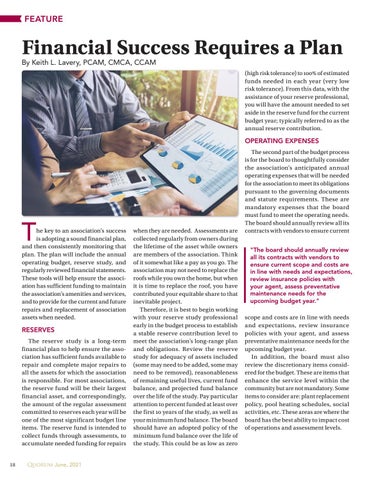FEATURE
Financial Success Requires a Plan
By Keith L. Lavery, PCAM, CMCA, CCAM
(high risk tolerance) to 100% of estimated funds needed in each year (very low risk tolerance). From this data, with the assistance of your reserve professional, you will have the amount needed to set aside in the reserve fund for the current budget year; typically referred to as the annual reserve contribution.
OPERATING EXPENSES
T
he key to an association’s success is adopting a sound financial plan, and then consistently monitoring that plan. The plan will include the annual operating budget, reserve study, and regularly reviewed financial statements. These tools will help ensure the association has sufficient funding to maintain the association’s amenities and services, and to provide for the current and future repairs and replacement of association assets when needed.
RESERVES The reserve study is a long-term financial plan to help ensure the association has sufficient funds available to repair and complete major repairs to all the assets for which the association is responsible. For most associations, the reserve fund will be their largest financial asset, and correspondingly, the amount of the regular assessment committed to reserves each year will be one of the most significant budget line items. The reserve fund is intended to collect funds through assessments, to accumulate needed funding for repairs 18
Quorum June, 2021
when they are needed. Assessments are collected regularly from owners during the lifetime of the asset while owners are members of the association. Think of it somewhat like a pay as you go. The association may not need to replace the roofs while you own the home, but when it is time to replace the roof, you have contributed your equitable share to that inevitable project. Therefore, it is best to begin working with your reserve study professional early in the budget process to establish a stable reserve contribution level to meet the association’s long-range plan and obligations. Review the reserve study for adequacy of assets included (some may need to be added, some may need to be removed), reasonableness of remaining useful lives, current fund balance, and projected fund balance over the life of the study. Pay particular attention to percent funded at least over the first 10 years of the study, as well as your minimum fund balance. The board should have an adopted policy of the minimum fund balance over the life of the study. This could be as low as zero
The second part of the budget process is for the board to thoughtfully consider the association's anticipated annual operating expenses that will be needed for the association to meet its obligations pursuant to the governing documents and statute requirements. These are mandatory expenses that the board must fund to meet the operating needs. The board should annually review all its contracts with vendors to ensure current "The board should annually review all its contracts with vendors to ensure current scope and costs are in line with needs and expectations, review insurance policies with your agent, assess preventative maintenance needs for the upcoming budget year." scope and costs are in line with needs and expectations, review insurance policies with your agent, and assess preventative maintenance needs for the upcoming budget year. In addition, the board must also review the discretionary items considered for the budget. These are items that enhance the service level within the community but are not mandatory. Some items to consider are: plant replacement policy, pool heating schedules, social activities, etc. These areas are where the board has the best ability to impact cost of operations and assessment levels.



